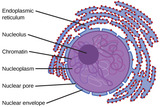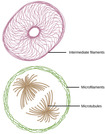
34 Results


ATP synthase and its role in mitochondria during respiration and chloroplasts during photosynthesis.
- Subject:
- Biology
- Life Science
- Material Type:
- Lesson
- Provider:
- Khan Academy
- Provider Set:
- Khan Academy
- Author:
- Sal Khan
- Date Added:
- 10/23/2018

Biology is designed for multi-semester biology courses for science majors. It is grounded on an evolutionary basis and includes exciting features that highlight careers in the biological sciences and everyday applications of the concepts at hand. To meet the needs of today’s instructors and students, some content has been strategically condensed while maintaining the overall scope and coverage of traditional texts for this course. Instructors can customize the book, adapting it to the approach that works best in their classroom. Biology also includes an innovative art program that incorporates critical thinking and clicker questions to help students understand—and apply—key concepts.
- Subject:
- Biology
- Life Science
- Material Type:
- Full Course
- Provider:
- Rice University
- Provider Set:
- OpenStax College
- Date Added:
- 08/22/2012

- Subject:
- Biology
- Life Science
- Material Type:
- Unit of Study
- Provider:
- Rice University
- Provider Set:
- OpenStax College

By the end of this section, you will be able to:List the unifying characteristics of eukaryotesDescribe what scientists know about the origins of eukaryotes based on the last common ancestorExplain endosymbiotic theory
- Subject:
- Applied Science
- Biology
- Life Science
- Material Type:
- Module
- Date Added:
- 07/10/2017

- Subject:
- Applied Science
- Biology
- Life Science
- Material Type:
- Module
- Date Added:
- 07/10/2017

- Subject:
- Biology
- Life Science
- Material Type:
- Unit of Study
- Provider:
- Rice University
- Provider Set:
- OpenStax College

By the end of this section, you will be able to:Describe the structure of eukaryotic cellsCompare animal cells with plant cellsState the role of the plasma membraneSummarize the functions of the major cell organelles
- Subject:
- Applied Science
- Biology
- Life Science
- Material Type:
- Module
- Date Added:
- 07/10/2017

- Subject:
- Applied Science
- Biology
- Life Science
- Material Type:
- Module
- Date Added:
- 07/10/2017

By the end of this section, you will be able to:Describe the cytoskeletonCompare the roles of microfilaments, intermediate filaments, and microtubulesCompare and contrast cilia and flagellaSummarize the differences among the components of prokaryotic cells, animal cells, and plant cells
- Subject:
- Applied Science
- Biology
- Life Science
- Material Type:
- Module
- Date Added:
- 07/10/2017

In this seminar you will use images to differentiate the structure of a chloroplast and mitochondria. You will follow an animation to learn about the two essential processes that take place in each cell organelle to accurately determine the importance of structure and function. You will also analyze data from mice to determine the effects of exercise and performance enhancing drugs on the presence of mitochondria in a cell, or extract chlorophyll from various levels to examine its function outside a chloroplast.StandardsBIO.A.3.1.1 Describe the fundamental roles of plastids (e.g., chloroplasts) and mitochondria in energy transformations.BIO.A.3.2.1 Compare and contrast the basic transformation of energy during photosynthesis and cellular respiration.BIO.A.3.2.2 Describe the role of ATP in biochemical reactions
- Subject:
- Biology
- Life Science
- Material Type:
- Lesson Plan
- Author:
- Bonnie Waltz
- Deanna Mayers
- Tracy Rains
- Date Added:
- 10/05/2017

This resource is a video abstract of a research paper created by Research Square on behalf of its authors. It provides a synopsis that's easy to understand, and can be used to introduce the topics it covers to students, researchers, and the general public. The video's transcript is also provided in full, with a portion provided below for preview:
"Alzheimer’s disease is a progressive brain disorder that gradually destroys memory and thinking skills Every year, the number of people affected by the disease continues to grow That has some researchers looking to the fruit fly for answers One team has found that linking two parts of the cell closer together may help Linking the endoplasmic reticulum, which forms proteins and stores calcium to the mitochondria, which power the cell can actually improve motor function in fruit flies and help them live longer This technique works in flies with brain plaques similar to those found in humans with Alzheimer’s disease Part of the reason could be improved access to calcium Forcing the organelles together helps calcium migrate more easily from the endoplasmic reticulum to the mitochondria This sends the mitochondria into overdrive because calcium acts as a lubricant for the mitochondrial machinery that pumps out energy So easy access to calcium means more energy output Clarifying how that transl.."
The rest of the transcript, along with a link to the research itself, is available on the resource itself.
- Subject:
- Applied Science
- Health, Medicine and Nursing
- Material Type:
- Diagram/Illustration
- Reading
- Provider:
- Research Square
- Provider Set:
- Video Bytes
- Date Added:
- 12/23/2019

This resource is a video abstract of a research paper created by Research Square on behalf of its authors. It provides a synopsis that's easy to understand, and can be used to introduce the topics it covers to students, researchers, and the general public. The video's transcript is also provided in full, with a portion provided below for preview:
"Cancer cells are abnormal cells that rapidly proliferate and often find ways to evade the immune system’s attempts to stop them. Such cells often overexpress the genes MYC and ARF6 and have a mutated version of the KRAS gene. These changes are inextricably linked and result in significant resistance to cancer therapies. KRAS activates MYC gene expression and possibly promotes the translation of the messenger RNA for both MYC and ARF6. Then MYC induces expression of genes related to mitochondrial formation and energy production. Meanwhile, ARF6 protects the mitochondria from oxidation-induced injury. ARF6 may also promote cancer invasion, metastasis, and immune evasion. Thus, KRAS, MYC, and ARF6 cooperate to help cancer spread and to avoid the immune system and immune-based treatments. These harmful associations are common in pancreatic cancer and can be strengthened by mutations in other genes like TP53..."
The rest of the transcript, along with a link to the research itself, is available on the resource itself.
- Subject:
- Biology
- Life Science
- Material Type:
- Diagram/Illustration
- Reading
- Provider:
- Research Square
- Provider Set:
- Video Bytes
- Date Added:
- 05/15/2023

This resource is a video abstract of a research paper created by Research Square on behalf of its authors. It provides a synopsis that's easy to understand, and can be used to introduce the topics it covers to students, researchers, and the general public. The video's transcript is also provided in full, with a portion provided below for preview:
"The physiological effects of melatonin are far reaching, from acting as an neuroprotective agent to regulating circadian rhythms and sleep cycles. An imbalance of this hormone has even been linked to neurodegenerative diseases such as Parkinson’s, Alzheimer’s, and Huntington’s. The precise molecular mechanism by which melatonin exerts these effects, however, remains a mystery. To shed light on this process, a team of researchers has developed a melatonin-like compound that is unable to penetrate the cell membrane and binds only to cell-surface receptors. Melatonin’s physiological effects on the brain are controlled by the lock-and-key-like properties of this hormone and its receptors. When melatonin binds to its corresponding receptor, a biochemical signal is sent into the cell. But recent data suggests that this interaction may also occur inside the cell, itself. Specifically, on mitochondria within brain cells..."
The rest of the transcript, along with a link to the research itself, is available on the resource itself.
- Subject:
- Applied Science
- Health, Medicine and Nursing
- Material Type:
- Diagram/Illustration
- Reading
- Provider:
- Research Square
- Provider Set:
- Video Bytes
- Date Added:
- 09/20/2019

This resource is a video abstract of a research paper created by Research Square on behalf of its authors. It provides a synopsis that's easy to understand, and can be used to introduce the topics it covers to students, researchers, and the general public. The video's transcript is also provided in full, with a portion provided below for preview:
"Diabetic kidney disease is one of the major causes of death in patients with diabetes and the leading cause of end-stage renal disease in the United States. One early sign believed to contribute to diabetic kidney disease is injury to the glomerulus. The glomerulus is a cluster of blood vessels in the kidney that filters excess fluid and waste products out of the blood. However, the molecular mechanisms that lead to irreversible glomerular injury in the setting of diabetes are poorly understood. To gain a clearer picture, researchers evaluated the impact of the diabetic microenvironment on glomerular endothelial cells. Prolonged exposure to diabetic serum affected mitochondria. resulting in cellular dysfunction, but not cell death..."
The rest of the transcript, along with a link to the research itself, is available on the resource itself.
- Subject:
- Biology
- Life Science
- Material Type:
- Diagram/Illustration
- Reading
- Provider:
- Research Square
- Provider Set:
- Video Bytes
- Date Added:
- 11/03/2020

The theory of how mitochondria, chloroplasts and other membrane-bound organelles in eukaryotic cell likely arose from a symbiosis between aerobic prokaryotes and host anaerobic eukaryotic ancestors. Developed by Lynn Margulis.
- Subject:
- Biology
- Life Science
- Material Type:
- Lesson
- Provider:
- Khan Academy
- Provider Set:
- Khan Academy
- Author:
- Sal Khan
- Date Added:
- 09/26/2018

This resource will allow students to practice matching eukaryotic cell organelles with definitions.
- Subject:
- Biology
- Material Type:
- Homework/Assignment
- Author:
- Jessica Sherburne
- Date Added:
- 06/01/2021

This resource is a video abstract of a research paper created by Research Square on behalf of its authors. It provides a synopsis that's easy to understand, and can be used to introduce the topics it covers to students, researchers, and the general public. The video's transcript is also provided in full, with a portion provided below for preview:
"Chloroplasts harness sunlight to power all the processes that help plants grow. Like engines, they must carefully balance their fuel to run efficiently. In plants, that’s the ratio of ATP to NADPH, two forms of fuel produced by photosynthesis. But scientists have long known that ATP/NADPH ratios in chloroplasts fall short of the value required for plants to turn CO₂ into sugars. To find out how plants overcome this imbalance, researchers tracked ATP in Arabidopsis plants in real time using a fluorescent protein sensor. They found that immature chloroplasts in young seedlings imported cytosolic ATP for chloroplast biogenesis, using an abundance of ATP transporter proteins to do the job, but mature chloroplasts downregulated these transporters to minimize ATP importation. Instead of importing ATP to maintain fuel balance, chloroplasts exported NADPH in the form of malate..."
The rest of the transcript, along with a link to the research itself, is available on the resource itself.
- Subject:
- Biology
- Botany
- Genetics
- Life Science
- Material Type:
- Diagram/Illustration
- Reading
- Provider:
- Research Square
- Provider Set:
- Video Bytes
- Date Added:
- 05/18/2022

In this activity on page 1 of the PDF, learners compare the relative sizes of biological objects (like DNA and bacteria) that can't be seen by the naked eye. Learners will be surprised to discover the range of sizes in the microscopic world. This activity can be followed up with a second activity, "What's in a microbe?", located on page 3 in the same resource.
- Subject:
- Biology
- Life Science
- Material Type:
- Activity/Lab
- Provider:
- Exploratorium
- Author:
- Julie Yu
- National Science Foundation
- The Exploratorium
- Date Added:
- 11/07/2006

The structure and role of mitochondria (plural for mitochondrion). Outer membrane, inner membrane, cristae, porins, etc.
- Subject:
- Biology
- Life Science
- Material Type:
- Lesson
- Provider:
- Khan Academy
- Provider Set:
- Khan Academy
- Author:
- Sal Khan
- Date Added:
- 07/27/2015